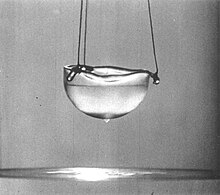Helium II
will "creep" along surfaces in order to find its own level—after a
short while, the levels in the two containers will equalize. The Rollin film also covers the interior of the larger container; if it were not sealed, the helium II would creep out and escape.
The
liquid helium is in the superfluid phase. A thin invisible film creeps
up the inside wall of the cup and down on the outside. A drop forms. It
will fall off into the liquid helium below. This will repeat until the
cup is empty—provided the liquid remains superfluid.
Superfluidity is the characteristic property of a fluid with zero viscosity which therefore flows without loss of kinetic energy. When stirred, a superfluid forms cellular vortices that continue to rotate indefinitely. Superfluidity occurs in two isotopes of helium (helium-3 and helium-4) when they are liquefied by cooling to cryogenic temperatures. It is also a property of various other exotic states of matter theorized to exist in astrophysics, high-energy physics, and theories of quantum gravity. Superfluidity is often coincidental with Bose–Einstein condensation, but neither phenomenon is directly related to the other; not all Bose-Einstein condensates can be regarded as superfluids, and not all superfluids are Bose–Einstein condensates. The semiphenomenological theory of superfluidity was developed by Lev Landau.
Superfluidity of liquid helium
Superfluidity was originally discovered in liquid helium, by Pyotr Kapitsa and John F. Allen. It has since been described through phenomenology and microscopic theories. In liquid helium-4, the superfluidity occurs at far higher temperatures than it does in helium-3. Each atom of helium-4 is a boson particle, by virtue of its integer spin. A helium-3 atom is a fermion
particle; it can form bosons only by pairing with itself at much lower
temperatures. The discovery of superfluidity in helium-3 was the basis
for the award of the 1996 Nobel Prize in Physics. This process is similar to the electron pairing in superconductivity.
Ultracold atomic gases
Superfluidity in an ultracold fermionic gas was experimentally proven by Wolfgang Ketterle and his team who observed quantum vortices in 6Li at a temperature of 50 nK at MIT in April 2005. Such vortices had previously been observed in an ultracold bosonic gas using 87Rb in 2000, and more recently in two-dimensional gases. As early as 1999 Lene Hau created such a condensate using sodium atoms for the purpose of slowing light, and later stopping it completely. Her team subsequently used this system of compressed light to generate the superfluid analogue of shock waves and tornadoes:
These dramatic excitations result in the formation of solitons that in turn decay into quantized vortices—created far out of equilibrium, in pairs of opposite circulation—revealing directly the process of superfluid breakdown in Bose-Einstein condensates. With a double light-roadblock setup, we can generate controlled collisions between shock waves resulting in completely unexpected, nonlinear excitations. We have observed hybrid structures consisting of vortex rings embedded in dark solitonic shells. The vortex rings act as 'phantom propellers' leading to very rich excitation dynamics.
— Lene Hau, SIAM Conference on Nonlinear Waves and Coherent Structures
Superfluid in astrophysics
The idea that superfluidity exists inside neutron stars was first proposed by Arkady Migdal. By analogy with electrons inside superconductors forming Cooper pairs because of electron-lattice interaction, it is expected that nucleons
in a neutron star at sufficiently high density and low temperature can
also form Cooper pairs because of the long-range attractive nuclear
force and lead to superfluidity and superconductivity.
In high-energy physics and quantum gravity
Superfluid vacuum theory (SVT) is an approach in theoretical physics and quantum mechanics where the physical vacuum is viewed as superfluid.
The ultimate goal of the approach is to develop scientific models
that unify quantum mechanics (describing three of the four known
fundamental interactions) with gravity. This makes SVT a candidate for the theory of quantum gravity and an extension of the Standard Model.
It is hoped that development of such theory would unify into a
single consistent model of all fundamental interactions,
and to describe all known interactions and elementary particles as
different manifestations of the same entity, superfluid vacuum.
On the macro-scale a larger similar phenomenon has been suggested as happening in the murmurations of starlings. The rapidity of change in flight patterns mimics the phase change leading to superfluidity in some liquid states.


